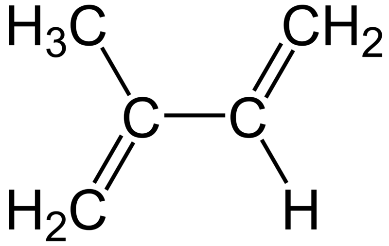
Which rubber is not polydiene?
(a) Polyisoprene
(b) Polychloroprene
(c) Thiokol rubber
(d) Nitrile rubber
Answer
561.9k+ views
Hint: Polydienes are polymers which have their monomer as a diene, which is essentially two carbon-carbon double bonds ($C = C$) occurring in the same molecule. Therefore, by examining structures of each compound, we can identify the rubber which doesn’t have diene in their monomer.
Complete step by step answer:
To approach this problem, let us have a close look at the structures of each rubber mentioned in the options.
The first rubber, polyisoprene, has the compound isoprene as its monomer (shown in figure). We can clearly see that this compound has two carbon-carbon double bonds and therefore, when polymerized, forms a polydiene.

The next compound, polychloroprene, has chloroprene as its monomer. The structure of chloroprene is shown in the figure below. As we can see, this molecule is a diene too as it has two carbon-carbon double bonds.

The third compound is Thiokol rubber, is formed from two monomers, namely 1,2-dichloroethane and sodium polysulphide. Sodium polysulphide consists only of sodium and sulphur atoms, and the structure of 1,2-dichloroethane is shown below. As we can see, even this molecule is not a diene as it doesn’t even have a double bond. Hence, Thiokol rubber is not a polydiene.

The last compound, nitrile rubber, is formed from two monomers, acrylonitrile and 1,3-butadiene. Out of these, the structure of 1,3-butadiene is shown below. As we can clearly see, this molecule has two carbon-carbon double bonds too. Therefore, when polymerized with acrylonitrile, it forms a polydiene.

As we can see from above, Thiokol rubber is the only polymer which does not have a diene monomer.
So, the correct answer is Option C.
Note: Dienes are constituents of the monomers of most natural and synthetic polymers. Presence of a diene molecule in any monomer will make its polymer a polydiene. Thiokol rubber has a branched chain structure of sulphur, which gives it added strength and more resistance to wear and tear. The process of adding cross-linked sulphur chains into natural rubber for enhancing its properties is known as vulcanization.
Complete step by step answer:
To approach this problem, let us have a close look at the structures of each rubber mentioned in the options.
The first rubber, polyisoprene, has the compound isoprene as its monomer (shown in figure). We can clearly see that this compound has two carbon-carbon double bonds and therefore, when polymerized, forms a polydiene.

The next compound, polychloroprene, has chloroprene as its monomer. The structure of chloroprene is shown in the figure below. As we can see, this molecule is a diene too as it has two carbon-carbon double bonds.

The third compound is Thiokol rubber, is formed from two monomers, namely 1,2-dichloroethane and sodium polysulphide. Sodium polysulphide consists only of sodium and sulphur atoms, and the structure of 1,2-dichloroethane is shown below. As we can see, even this molecule is not a diene as it doesn’t even have a double bond. Hence, Thiokol rubber is not a polydiene.

The last compound, nitrile rubber, is formed from two monomers, acrylonitrile and 1,3-butadiene. Out of these, the structure of 1,3-butadiene is shown below. As we can clearly see, this molecule has two carbon-carbon double bonds too. Therefore, when polymerized with acrylonitrile, it forms a polydiene.

As we can see from above, Thiokol rubber is the only polymer which does not have a diene monomer.
So, the correct answer is Option C.
Note: Dienes are constituents of the monomers of most natural and synthetic polymers. Presence of a diene molecule in any monomer will make its polymer a polydiene. Thiokol rubber has a branched chain structure of sulphur, which gives it added strength and more resistance to wear and tear. The process of adding cross-linked sulphur chains into natural rubber for enhancing its properties is known as vulcanization.
Recently Updated Pages
A man running at a speed 5 ms is viewed in the side class 12 physics CBSE

State and explain Hardy Weinbergs Principle class 12 biology CBSE

Which of the following statements is wrong a Amnion class 12 biology CBSE

Two Planoconcave lenses 1 and 2 of glass of refractive class 12 physics CBSE

The compound 2 methyl 2 butene on reaction with NaIO4 class 12 chemistry CBSE

Bacterial cell wall is made up of A Cellulose B Hemicellulose class 12 biology CBSE

Trending doubts
Explain sex determination in humans with line diag class 12 biology CBSE

The pH of the pancreatic juice is A 64 B 86 C 120 D class 12 biology CBSE

Which prominent US inventor was known as the Wizard class 12 social science CBSE

Which state in India is known as the Granary of India class 12 social science CBSE

Draw a ray diagram of compound microscope when the class 12 physics CBSE

When was the first election held in India a 194748 class 12 sst CBSE




